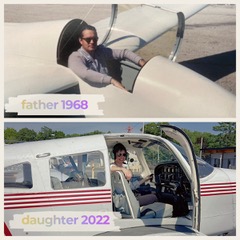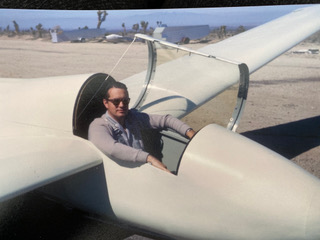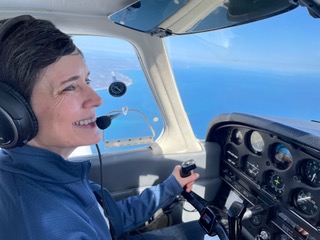|
Getting your Trinity Audio player ready...
|
I wriggled around my dad’s legs and tried to peer over the car hood as he wrote in his sailplane logbook. He picked me up and stood me on top of his sturdy brown shoes. With his ballpoint pen as a pointer, he helped me read: Thermals off second ridge, contacted weak wave over rock pile. Increased to 3–4 kts. Landed at sundown. But as a six-year-old, the meaning was as inscrutable as his organic chemistry quizzes.
I had spent the day playing in the shade of our VW Squareback while looking upward toward the graceful wings of his sailplane. Cool cans of ginger ale relieved the Wisconsin summer heat. The trilling calls of wrens nesting in the hangars were occasionally masked by the drone of tow planes. The field smelled like warm hay, and even as the hours ticked by, the day seemed to lengthen. But as the shadows grew long, he clicked his pen shut and closed his logbook. He set me down on the hard grass and took me by the hand.
It would be forty-five years until I followed my father into the sky. And when he passed away, his logbooks helped keep me from going completely off course.
I had shown him my first logbook entry two years before he died. Dad was ninety-five then, and hadn’t flown in over thirty years due to a vision issue. Even though he was retired from a long career as a chemistry professor, he still wore his trademark uniform of beige pants, brown belt and shoes, and white shirt. He pulled his pen from his shirt pocket and used it to follow along my first logbook entry. I knew what it said: Discovery flight – Nice job flying! But even though Dad’s sailplane had hovered in the background of my life, aviation had never sparked my interest. Instead, I had developed a fear of flying. By my fiftieth birthday, I was fed up and decided that a flight in a general aviation airplane might help me overcome my fears.
So on a bright midsummer morning just south of the Boston Bravo airspace, we departed in a Cessna 172. When the instructor started the plane, I wanted to bolt, and it took half the flight for him to coax me to take the controls. When I finally held the yoke, my fingers were slick with nervous sweat. But cool air streamed through the vents, and the plane seemed to tolerate my clumsy inputs—even at times seemed to buzz along happily. To the north, the rugged Boston skyline stoically filled the coast; to the south, the long green arm of Cape Cod languidly curled into the ocean. I was suspended between heaven and earth by the harmony of the airplane. In that moment, I fell in love with flying.
My dad looked up from my logbook, his eyes still professorial and sharp.
“That’s a nice start,” he said. “Now you need to fill it up.”
“I did really enjoy it, but even on the commercial flight here, the smallest bump makes me grip the armrest.”
“Well,” he said, leaning forward and sliding the logbook across the dining room table, “you can get used to that. Back in California, the first time I flew a mountain wave was a surprise. I went out to the field one day and my instructor Fred said, You’re going wave flying today.”
Fred had shown him how to use the high-altitude gear: boots, cold-weather suit, and oxygen. He launched from Crystalaire near the San Gabriel Mountains and flew over the tawny brown desert. Strong winds blew eastward from the Pacific Ocean and funneled through a valley before cresting the mountain, flowing downward to the earth and deflecting upward again.
“It’s going around like this,” he said, gesturing with his fingers in a spiral. “It’s very turbulent. And when I say very turbulent, that’s mild. It was up and down, side to side, all at the same time. If you ever experienced that in a plane, it would scare the hell out of you.”
“I didn’t quite know how to fly it at first,” he said, leaning back and crossing his hands on his lap. “Eventually I figured it out and found the laminar flow. That changes everything. There was no turbulence. No sound. It was absolutely quiet, and you go straight up—a total vertical ascent, like an elevator.”
I can see him there in his sailplane, slender wings lifting easily, as below the mountains shrunk to small undulations rippling across the desert.
He set his personal record that day with an altitude of 18,000 feet and earned his sailplane pilot’s Silver Badge.
His logbook entry from that day says: Wave flight, High 14,900 ASL, Alt gain 5300’ Silver C alt. Then a month later came the big wave flight: Wave flight, High 18,000’ ASL, Alt gain 13,100’ Gold alt.
 After my discovery flight, I kept training—piecemeal at first, then in earnest. Eventually, I became proficient and was signed off to solo. With a high overcast and light winds, I guided the Piper Warrior through three tidy laps in the pattern and three tidy-enough landings. I sent my dad a video of one of my landings—complete with CTAF short final radio call—taken from the field by my flight instructor.
After my discovery flight, I kept training—piecemeal at first, then in earnest. Eventually, I became proficient and was signed off to solo. With a high overcast and light winds, I guided the Piper Warrior through three tidy laps in the pattern and three tidy-enough landings. I sent my dad a video of one of my landings—complete with CTAF short final radio call—taken from the field by my flight instructor.
“I saw it,” Dad said through the phone, “and I heard you loud and clear! Just fantastic!”
I used an electronic logbook that day and took delight in tapping the button to mark my first entry as Pilot in Command.
A few months after my solo, I flew from Boston to Chicago for Dad’s ninety-eighth birthday. But before I arrived, he had a massive heart attack, and by day’s end we knew his time was growing short.
At the hospital, I kissed his gray cheek and held his hand. His eyes—still sharp and professorial—locked me into place.
“I’m in rough shape,” he said. “Here’s what I want: no more interventions. If this is it, let it be.” He squeezed my hand. “Do you understand?”
Of course I did.
I was alone with him the next day when he had another heart attack. After alerting the family to come to the hospital quickly and coordinating with his team for pain medication, I took his hand.
The muscles in his hand were thick and strong, even as they became cold. These hands had guided his sailplane in the mountains, had written logbook entries, and had always guided me. I kept holding his hand while his blood pressure dropped and until he exhaled his final breath.
I whispered, Thank you. I love you.
Then I let go.
A few months after his passing, we held a celebration of life. After the throngs left, I went into his study. His beige sweater lay folded across the top of his desk chair. I looked at the rows of chemistry textbooks that lined his shelves; tucked among them were his slim logbooks.
I sat on the floor and opened them. The entries, so inscrutable to me as a child, now revealed their patterns. All the pre-solo work was shown in the handwriting of his instructor; his first Pilot in Command flights marked by the change to his own handwriting; the gradual expansion of boundaries in time, distance, and altitude. His cross-country flying. His competitions in Illinois, Wisconsin, and Michigan. His growing confidence revealed line by line.
I tucked two of the logbooks into my bag and took them back to Boston with me.
After he passed, I took a month off from flying. The shock of feeling adrift came as a surprise—for fifty-two years he had been a guiding presence.
But gradually, I returned to training and was soon signed off for my first solo to a non-towered airport. And recently I flew solo to a towered airport. For the first time during that flight, I was in the zone—an aviator. When I filled out my logbook, it felt like my own progress was finally being revealed, line by line.
I no longer need a boost to see over the car hood, nor do I need help reading logbook entries—but after each flight, I still say: I wish I could tell Dad.
I keep his logbooks with me. They rotate between my office, car, and nightstand. They remind me that even though I may feel adrift, he is always there to help me stay on course.
- Dad’s Logbooks: Keeping a Daughter on Course - August 6, 2025






Your dad’s flight to 18,000 reminded me of my older brothers flight to 14,600 in his home built Aeronca TG-5 that he converted to power. That was back in the early years after WW2 when LA basin was full of surplus aircraft parts and pieces.
Mike what a super cool memory! I was just at an airshow up in Maine that featured a lot of WW2 era planes; the museum curator commented about how after the war many planes were just left laying around. Sounds like your brother put it to good use!
Wonderful story. Old logbooks can bring such joy.
Thanks, Bruce! I do like my electronic log book and the ability to add photos is pretty cool…however there is a kind of magic in the handwriting and paper logs that can’t be equalled!
Gita, What a wonderful tribute to your dad and such a wonderful style in which you presented it to us. Your dad sparked your interest in flying and I believe he will always be with you as you fly, because you learned from his logbook and what he conveys to you through his logbook is becoming a part of your logbook — he will remain a part of your life.
Thanks so much for your comment, brought a tear to my eye. He is truly with me; this weekend is the one-year anniversary of his death and would have been his 98th birthday! We’ve been going through his things and have found some of the original instruments–including an altimeter–from his sailplane, pretty cool. I’ve enjoyed reading your pieces here on AirFacts over the past few years, as well, thanks again!
Great article and so well-written. Thanks for sharing your story with all its emotional depth.
So, are you over the fear of flying commercial that led you to general aviation? I’ve heard others say that pilot training helps to calm the nerves when flying commercial. My experience was similar, but I didn’t get to pilot training until suffering through decades of frequent commercial flying. I wish I had done it sooner (for that and many other reasons).
I’m also wondering if you’re going to take up flying gliders, if you haven’t already? Your father’s gliding career sounds super ambitious and interesting. But there’s tons of fun to be had just by sticking in sight of the field. Try it if you haven’t!
Hi Evan, thanks for reading! Yes I am over the fear of flying commercial! A lot of it has to do with a group called Lovefly-a community/podcast/courses-that functions on the premise of “Rethink your Approach – Redefine your Fear”. Fantastic group and resources that really helped me see things in new ways. Of course, taking aviation training first-hand and having the exposure of handling the aircraft itself was part of the change! But there is a subtle, yet critical, piece of unpicking the “need for control” that is a bit of the equation, as well. For me it’s been mindset + information=changing my relationship to fear. I no longer see fear as a weakness, but a strength that has helped me understand myself–and the world–with more clarity.
And yes of course gliders on on my “to-do” list! Absolutely! Really looking forward to that experience!
I’m on the opposite side of aviation. When I was six, all I wanted to do was fly. I feel very fortunate to have been paid for it Throughout a long career. I’m retired now but wanted to tell Gita how much I loved reading her article about her dad’s and her own flying experiences. And kudos for overcoming her fear by actually taking lessons!
Thanks so much for reading, Joe. I hear from lots of aviators that “the bug” bit them early; glad you had a fruitful career! Taking lessons has been one of the great unexpected adventures of midlife, in a wild way I’m actually grateful to my fear for getting my attention focused on aviation!
Gita, thank you so much for sharing this story. My late dad was also bigger than life; and in my adult years I would still occasionally seek his advice.
You are so welcome, thanks for reading and sharing your thoughts. The advice of a trusted elder who knows us well is invaluable at every life stage!
Beautiful story and writing Gita thanks for sharing. My dad’s logbooks are among my most valued possessions.
Hi Shane! How wonderful that you have your dad’s logbooks, as well. Love how they keep us connected across time.
Gita, a beautiful story elegantly told. I hope you will write more as you progress to your PPL. I, too, took up flying only after my father’s death at 61. As others have written, years of business flying hadn’t decreased my nervousness and Dramamine dependency. But after earning my PPL and instrument rating, and owning two airplanes, I flew the airlines with equanimity, and satisfaction from understanding what was happening with the airplanes.
Hunter Heath
Thanks so much for your comment, I will definitely keep writing! So interesting to hear that you were a nervous flier, as well. Turns out fear is fairly common; once we start talking about it we realize that it’s a very normal reaction to a very novel experience. Love your line about flying with “equanimity”, that’s a wonderful mindset andI’m inspired by your successes!
Gita, I’m so proud of you! You made it into a pretty exclusive club! Keep going!
The bug bit me as a toddler. My parents told me that I seemed to be born with a toy airplane in my hand. I only got as far as my Private ticket, 200 hours, and a few fam rides in sailplanes. If i could go back, I’d go for my Sailplane rating. I wanted to make a career out of it, but life…I ended up working on the ground for a large regional carrier. I can’t fly solo anymore for health reasons, and I miss it terribly.
Maybe someday after I’m gone, one of my daughters will open my logbook and wonder.
Please keep writing about your adventures.
Thanks for your kind words, Gregg! I will indeed keep going! Very cool that you made a life for yourself in aviation. And your line about your daughters someday reading your logbooks is so moving! Thanks again.
Gita,
I was bitten by aviation and flying at a very early age. I guess that was inspired by my late Dad. I can remember sitting in the right seat of the family Aeronca Sedan and not being able to reach the rudder pedals or see over the instrument panel. I did make a career in aviation and now am retired. I too have Dad’s logbooks……Your story brought tears……
Dan
Dan I’m so glad you shared your story; what a cool memory of the family Aeronca. That is a unique experience and I’m sure a treasured moment. Love that you have your dad’s logbooks, too. So touching!
A beautiful story Gita. I’ve been a glider pilot for nearly 40 years now .. we are truly lucky people to be able to do what we do!
Wonderful to fly gliders for 40 years! What a unique experience and empowering way to see the world. We are truly lucky, I agree.
Gita, we seem to have a genial “who got the bug earliest,” contest going. I offer this. Born in 1942 Dallas, lots of military traffic came over our house, and Dad hung a model B-24 over my crib. My mother swore that my first word was “airplane-o.” A bit of paternal coaching may have been involved. Dad was 9 when Lindbergh crossed the Atlantic, and that’s when he and many boys all over the world were bitten.
Haha! “Who got bit first” is awesome; how could you have said any other word other than airplane with that bit of visual–and paternal–coaching?! How exciting to have a memory of when Lindbergh crossed the pond, I can imagine the way people’s minds opened up to the possibilities of flight during that era!
Yes. I often wish I could tell Dad. He was my aviation mentor as well. Thank you.